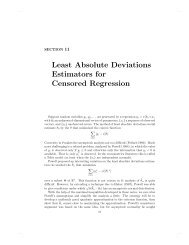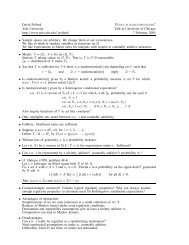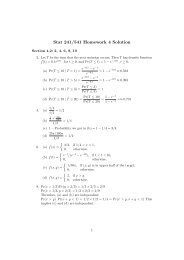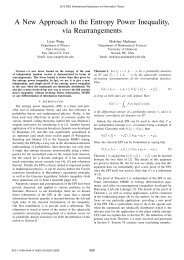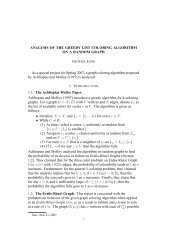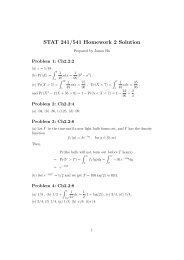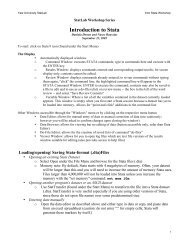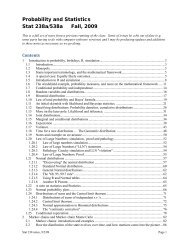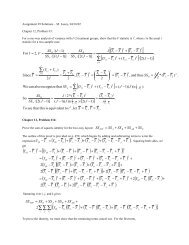Anderson's lemma
Anderson's lemma
Anderson's lemma
You also want an ePaper? Increase the reach of your titles
YUMPU automatically turns print PDFs into web optimized ePapers that Google loves.
Appendix DVector LatticesProof.Define the u ij as in the following table:u 11 = x 1 ∧ y 1 u 12 = (y 1 − x 1 ) + y 1u 21 = (y 2 − x 2 ) + u 22 = y 2 ∧ x 2 y 2x 1 x 2 x 1 + x 2 = y 1 + y 2Check the first row sum:x 1 ∧ y 1 + (y 1 − x 1 ) + = (x 1 ∧ y 1 ) + (y 1 ∨ x 1 ) − x 1 = x 1 + y 1 − x 1Interchange subscripts 1 and 2 to check the second row sum. Interchange theroles of x and y, then use the fact that y 2 − x 2 = x 1 − y 1 to check the column□ sums.splitting.ineq Corollary. If w, x 1 , x 2 ∈ V + and w ≤ x 1 + x 2 then there exist w i ∈ V +such that w = w 1 + w 2 and w i ≤ x i for i = 1, 2.□ Proof. let y 1 = w and y 2 = x 1 + x 2 − w.sum.orthog Exercise. Suppose x ∈ V and y 1 , y 2 ∈ V + and x ⊥ y i for i = 1, 2. Showthat x ⊥ (y 1 + y 2 ) and x ⊥ (y 1 − y 2 ).Solution: Suppose 0 ≤ w =|x|∧(y 1 + y 2 ). Split w into a sum w 1 + w 2 ,with 0 ≤ w i ≤ y i . Note w i ≤|x|.w = w 1 ∧|x|+w 2 ∧|x| ≤y 1 ∧|x|+y 2 ∧|x| =0.Thus |x| ⊥(y 1 + y 2 ).The second assertion follows from the first and the fact that |y 1 − y 2 |≤□ y 1 + y 2 .[§] 3. Order-bounded linear functionalslet V be a vector lattice. A linear map λ from V into R is to be an orderbounded linear functional if, for each pair a ≤ b,sup{|λ(x)| : a ≤ x ≤ b} < ∞A linear map λ from V into R is to be an increasing linear functional ifλ(x) ≤ λ(y) whenever x ≤ y. Equivalently, a linear functional is increasing ifλ(x) ≥ 0 for all x ∈ V + . The space V # of all order-bounded linear functionalson V is called the order dual of V .fnal.ordering Definition. Define λ 1 ≤ λ 2 to mean that λ 1 (x) ≤ λ 2 (x) for all x in V + .The key facts about linear functionals are that(i) The order dual V # is a vector lattice.(ii) Each λ in V # can be expressed as a difference of two increasing linearfunctionals.extension Lemma. Let λ : V + → R satisfy(i) λ(αx + βy) = αλ(x) + βλ(y) for all α, β ∈ R + and x, y ∈ V +(ii) For each w in V + ,sup{|λ(x)| :0≤ x ≤ w} < ∞Then λ has a unique extension to an order-bounded linear functional on V .Proof. Define λ(u) = λ(u + ) − λ(u − ). Check that if x 1 − x 2 = y 1 − y 2 thenλ(x 1 ) − λ(x 2 ) = λ(y) 1 − λ(y 2 ). Deduce linearity.Asymptopia: 4Jan99 c○David Pollard 3



